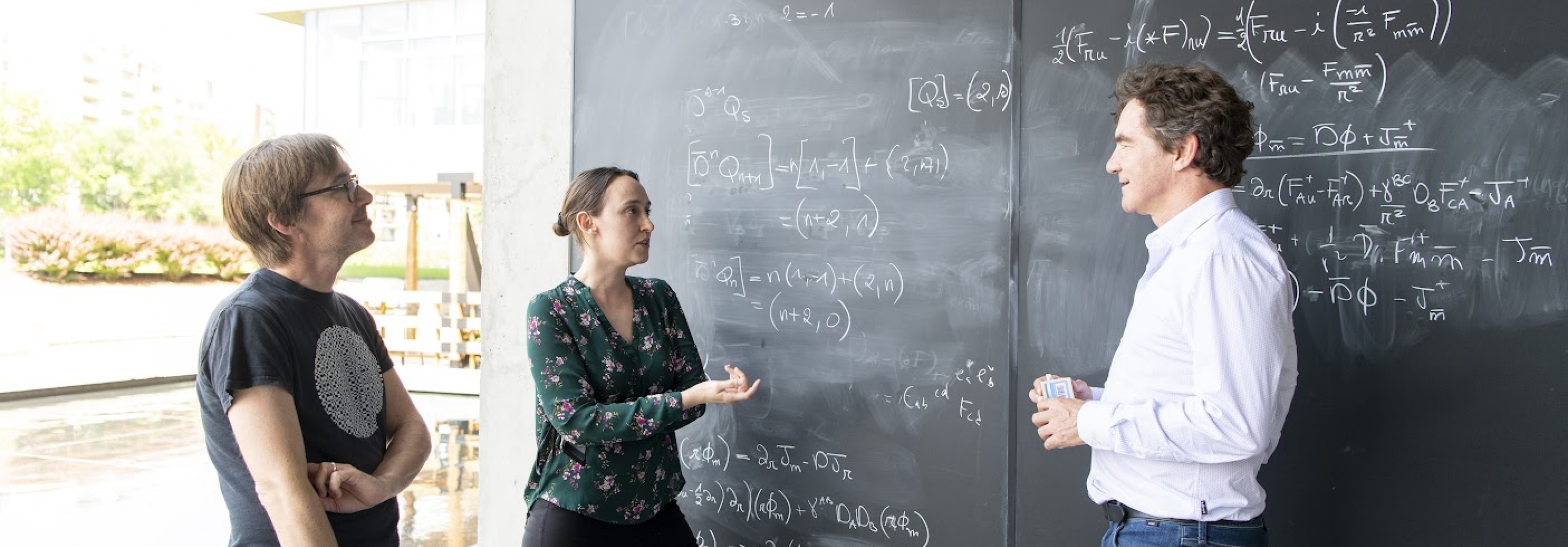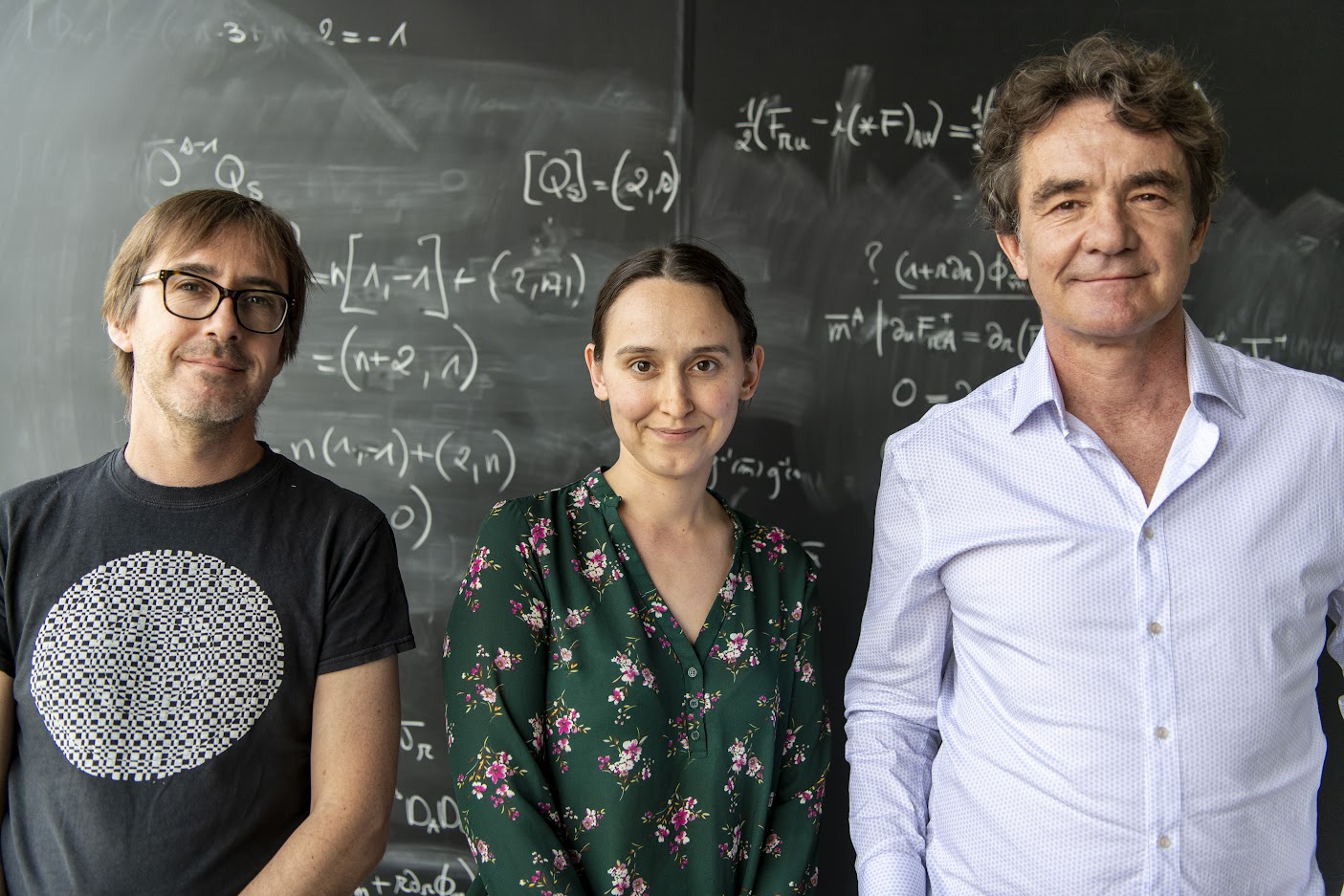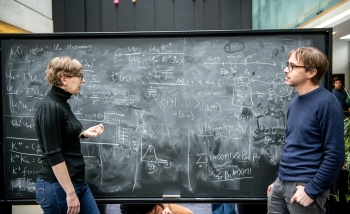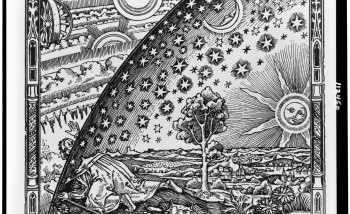Three Perimeter researchers launch new Simons Collaboration
Three Perimeter Institute faculty are founding members of a new international research collaboration focused on making strides in the emergent field of Celestial Holography: a promising avenue for unifying quantum mechanics and general relativity within an astrophysically relevant framework.
The fundamental idea of celestial holography is that the physics of the universe around us can be described as a projection on the ‘celestial sphere’: the place one reaches at the ultimate end of any direction you point to in the night sky. It builds upon the holographic principle, which hypothesizes that any theory of quantum gravity has an equivalent ‘dual’ presentation without gravity living on the spacetime boundary.
String theorists previously found one such equivalence, the Anti-de Sitter/Conformal Field Theory correspondence, that connects negatively curved spacetime with certain field theories. But our actual universe has a (slightly) positive curvature. The Simons Collaboration on Celestial Holography will search for a more generalized duality that better fits our universe and connects more directly with gravitational wave observations.
It is a complex undertaking that merges expertise from the amplitudes, mathematical physics, and quantum gravity communities.
Recent advances made at Perimeter have played a pivotal role in bringing this goal within reach. It was the first institute worldwide to invest in a junior celestial holographer, appointing one of the field’s pioneers, Sabrina Pasterski, to the faculty in 2021 and launching the Celestial Holography Initiative under Pasterski’s leadership. This initiative was designed to bring together researchers from across Perimeter’s Quantum Fields and Strings, Quantum Gravity, and Mathematical physics groups.
A core piece of the puzzle is the search for new symmetries – patterns or equivalences within the laws of nature that can help simplify complexity and unify disparate theories. Pasterski’s research prior to joining Perimeter included the discovery of infinite dimensional symmetry enhancements of the S-matrix, a new observable memory effect in gravity, and a framework for generalizing these features of infrared physics to other theories.
This bottom-up line of research, being developed at Harvard under the guidance of Collaboration Director and Perimeter DVRC Andrew Strominger, also intersected with Perimeter faculty member Laurent Freidel’s ongoing research program on local holography. There, an organizing principle called corner symmetry offers a framework for understanding quantum gravity that can be naturally applied to the celestial sphere.
Yet another, wholly different approach to celestial holography is to construct it mathematically from the top-down. Perimeter faculty member Kevin Costello, whose discoveries in ‘twisted holography’ were ground-breaking in his own field, found recently that his research could also be applied in this area, and it intersected neatly with Pasterski and Freidel’s efforts.
Suddenly, different areas of research – conformal field theory, quantum gravity, twistor theory – were coming together in exciting ways. It is because of this synergy that the Simons Collaboration on Celestial Holography was born. The Perimeter team is now excited to transform its role from that of an incubator to an accelerator for this exciting new field.
“There is definitely a buzz of excitement. We’re starting to finally see how to fit together a lot of pieces of the puzzle we’ve been building for the last decade” says Pasterski “and Perimeter is the perfect place to make it happen.”
“Perimeter is ideally placed because it covers many different aspects of the problem,” agrees Freidel. “We are now at a crossroads where three different faculty representing three different fields at Perimeter are going to work together in a new research program, enriching that research program tremendously. This is quite unique in a way, and shows Perimeter doing what Perimeter does best: stay at the forefront, be innovative, and enable broad collaboration.”
"It was really serendipitous,” adds Costello, “that my research in mathematical physics touched on the problems studied in celestial holography by Sabrina, and also connected with Laurent’s work on quantum gravity. There is a very strong team in this collaboration and I'm excited to see what we can achieve.”
Modern physics, all too often, gets siloed: scientists become experts in very narrow arenas. The magic happens when distinct fields are unexpectedly brought together by newly emerging connections. Besides building off of the recent three-way collision of bottom-up efforts in celestial holography, parallel mathematical developments in topological field theory, and twistor theory, the new collaboration is similarly initiating new marriages between theoretical physics and observational physics.
“Some parts of celestial holography are old physics from the last century, others are new,” says Freidel, “but what is exciting about all of it is that we are discovering relationships between them that haven’t been explored before.”
One new piece of the celestial holography puzzle, for example, is a spin memory effect proposed by Pasterski. As gravitational waves ripple through the universe, they cause distortions that don’t entirely disappear after the waves pass – a ‘memory’ remains of the event which might be observationally detected by LIGO or next generation gravitational wave detectors. Such a detection would offer hard evidence connecting to the more theoretical pieces of celestial holography.
Freidel, Costello, and Pasterski are teaming up with 10 international colleagues as Principal Investigators of the collaboration, many of whom have previous associations with Perimeter Institute as visiting fellows or postdocs, and all of whom bring a wealth of expertise and experience. Together, the collaborators have the potential to make real progress, and what they find may have far-reaching implications for how we understand our universe.
The Simons Collaboration on Celestial Holography is funded by the Simons Foundation. It provides opportunities for postdoctoral researchers, and will host biennial summer schools for graduate students, the first of which will be held at Perimeter Institute in 2024. Members of the collaboration will engage in week-long team meetings three times per year, and will also work together through personnel exchanges and virtual seminars. The Simons Foundation has funded the collaboration for four years.
The Principal Investigators are: Tim Adamo at Edinburgh, Nima Arkani-Hamed at IAS, Kevin Costello, Laurent Freidel and Sabrina Pasterski at Perimeter, Jordan Cotler and Andrew Strominger (DVRC) at Harvard, Lionel Mason at Oxford, Natalie Paquette (Visiting Fellow) at University of Washington, Monica Pate at NYU, Andrea Puhm (Visiting Fellow) at University of Amsterdam, David Skinner at Cambridge, and Tomasz Taylor at Northeastern
About PI
Perimeter Institute is the world’s largest research hub devoted to theoretical physics. The independent Institute was founded in 1999 to foster breakthroughs in the fundamental understanding of our universe, from the smallest particles to the entire cosmos. Research at Perimeter is motivated by the understanding that fundamental science advances human knowledge and catalyzes innovation, and that today’s theoretical physics is tomorrow’s technology. Located in the Region of Waterloo, the not-for-profit Institute is a unique public-private endeavour, including the Governments of Ontario and Canada, that enables cutting-edge research, trains the next generation of scientific pioneers, and shares the power of physics through award-winning educational outreach and public engagement.




